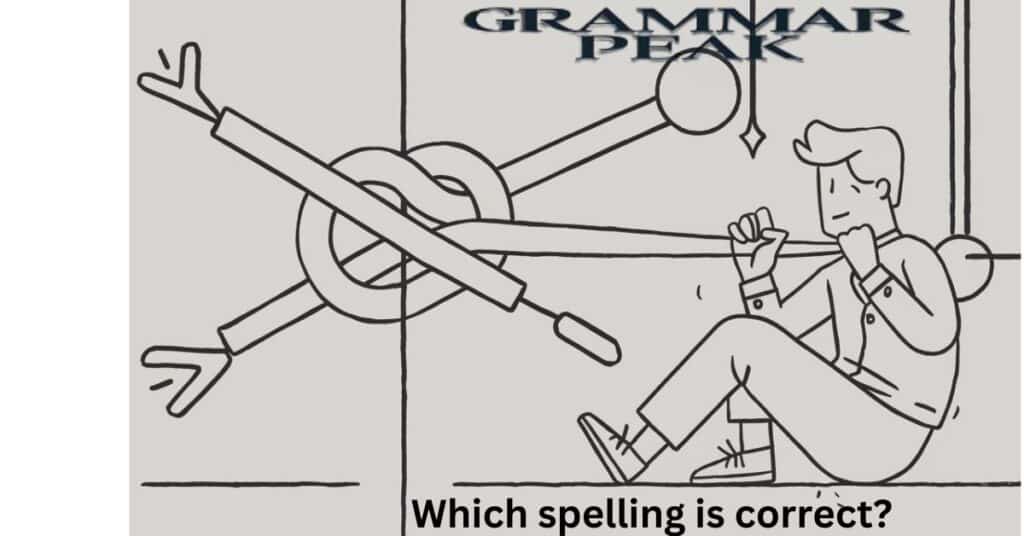Tying or Tieing, which one is correct? Good spelling can be more confusing than you might think when it comes to the English language. For example, “tie” is an excellent example of “I”-“e” changing to the more generic “y” point for the present participle.
The present participle of the verb to tie should be spelled Tying. The confusion probably arises from a common spelling rule of English changing letters -ie to -y with endings. However, “tieing” is wrong.
Why is There Confusion?
The confusion stems from the English spelling rules. For verbs ending in
Here are 10 examples of converting verbs ending in -e to their present participle forms:
- “Make” becomes “making”. In this case, the final -e is dropped before adding -ing.
- “Write” becomes “writing”. Here too, the -e is dropped when forming the present participle.
- “Take” becomes “taking”. The final -e is dropped before adding -ing.
- “Give” becomes “giving”. Similarly, the -e is dropped in the present participle form.
- “Live” becomes “living”. The final -e is removed before adding -ing.
- “Move” becomes “moving”. The -e is dropped when forming the present participle.
- “Have” becomes “having”. In this case, the -e is dropped and -ing is added.
- “Love” becomes “loving”. Here, the -e is dropped in the present participle form.
- “Hope” becomes “hoping”. The final -e is removed before adding -ing.
- “Come” becomes “coming”. The -e is dropped when forming the present participle.
Confusion often arises with the -ie to -y rule due to the inconsistent nature of English spelling conventions. While many words follow this rule when changing from a noun or adjective to a verb form, there are several exceptions,
Must be read Tying or Tieing? The Right Way to Spell It
“Tying” or “Tieing”: Which is Correct?
When it comes to the dilemma of “Tying or Tieing: which is correct?”, the answer is undoubtedly “Tying.” The correct spelling of tying follows the rule of changing -ie to -y. Thus, “tieing” is deemed incorrect in all contexts of English grammar.
Sure, let’s explore 10 more examples of verbs ending in -ie and their correct present participle forms:
- “Die” or “Dieing”: Which is correct? The correct spelling is undoubtedly “Dying.” The rule of changing -ie to -y applies here, making “dieing” incorrect.
- “Lie” or “Lieing”: Which is correct? The correct spelling is “Lying.” Following the rule of changing -ie to -y, “lieing” is incorrect.
- “Tie” or “Tieing”: Which is correct? The correct spelling is “Tying.” The rule of changing -ie to -y applies, so “tieing” is incorrect.
- “Pie” or “Pieing”: Which is correct? The correct spelling is “Pying.” By changing -ie to -y, we confirm that “pieing” is incorrect.
- “Untie” or “Untieing”: Which is correct? The correct answer is “Untying.” The rule of changing -ie to -y makes “untieing” incorrect.
- “Simplifie” or “Simplifieing”: Which is correct? The correct spelling is “Simplifying.” By changing -ie to -y, “simplifieing” becomes incorrect.
- “Purifie” or “Purifieing”: Which is correct? The correct spelling is “Purifying.” By changing -ie to -y, “purifieing” is incorrect.
- “Clarifie” or “Clarifieing”: Which is correct? The correct spelling is “Clarifying.” By following the rule of changing -ie to -y, we confirm that “clarifieing” is incorrect.
- “Justifie” or “Justifieing”: Which is correct? The correct spelling is “Justifying.” By changing -ie to -y, “justifieing” becomes incorrect.
- “Multiplie” or “Multiplieing”: Which is correct? The correct spelling is “Multiplying.” The rule of changing -ie to -y makes “multiplieing” incorrect.
What Does “Tying” Mean?
The term “Tying” signifies the act of fastening or securing, often related to tying a knot. It’s a verb that denotes the action of making a knot or a bow in something like
Here are 10 examples explaining the meaning of “Tying” in different contexts:
- Tying a shoelace ensures your shoes stay on your feet.
- In commerce, Tying (informally, product tying) is the practice of selling one product or service as a mandatory addition to purchasing a different product or service).
- Tying a ribbon around a gift box enhances its presentation.
- In sports, Tying the score means both teams have an equal number of points.
- Tying a knot in a thread is essential before starting to sew.
- In relationships, Tying the knot is a colloquial term for getting married.
- Tying a bandana around your head can be a fashion statement or practical headwear.
- In cooking, Tying the herbs together makes it easier to remove them after they’ve flavored the dish.
- Tying a scarf around your neck can keep you warm in cold weather.
- In business, Tying agreements can refer to the practice of making the sale of one product conditional on the purchase of another product).
These examples illustrate the various meanings and uses of “Tying” in different contexts, highlighting its versatility in the English language.
You might Be Tying or Tieing? The Right Way to Spell It
Words Following the -ie to -y Rule
Here’s a table showing 12 examples of words following the -ie to -y rule. This rule is typically applied when converting a noun or adjective to a verb in English.
| Noun/Adjective (-ie) | Verb (-y) |
| Die | Dying |
| Lie | Lying |
| Tie | Tying |
| Pie | Plying |
| Vie | Vying |
| Untie | Untying |
| Spy | Spying |
| Comply | Complying |
| Apply | Applying |
| Reply | Replying |
| Deny | Denying |
| Satisfy | Satisfying |
In each pair, the verb form changes the -ie ending to -y. This is a common rule in English spelling and is used to maintain the correct pronunciation of these words when their form changes.
Synonyms of “Tying”
There are several synonyms for tying,
Here are 12 sentences using synonyms for “Tying”:
- Securing: He was securing the tent to the ground with stakes to ensure it wouldn’t blow away in the wind.
- Fastening: She was fastening her necklace around her neck before heading out for the evening.
- Binding: The chef was binding the herbs together with a string before adding them to the soup.
- Knotting: He was knotting the rope securely to ensure the boat wouldn’t drift away.
- Lashing: She was lashing the luggage to the roof of the car before they set off on their road trip.
- Linking: The detective was linking the clues together to solve the mystery.
- Connecting: He was connecting the wires to complete the circuit.
- Joining: She was joining the pieces of fabric together to create a beautiful quilt.
- Fixing: He was fixing the sign to the wall so that it wouldn’t fall.
- Securing: She was securing her hair in a bun before starting her workout.
- Anchoring: He was anchoring the ship to the seabed to prevent it from drifting.
- Stabilizing: She was stabilizing the structure by tying the beams together.
These sentences illustrate the use of various synonyms for “Tying” in different contexts, highlighting its versatility in the English language.
Sentences Using “Tying”
To understand the correct use of “tying,” consider these sentences:
Here are 12 sentences using the word “Tying”:
- Tying your shoelaces properly can prevent tripping while walking.
- She spent the afternoon tying colorful ribbons around the chairs for the wedding.
- Tying the fishing line to the hook is essential for a successful catch.
- He was tying the packages together to make them easier to carry.
- Tying a scarf around your neck can add a stylish touch to your outfit.
- The children enjoyed tying balloons together to create a festive decoration.
- Tying the two pieces of wood together helped stabilize the structure.
- She was tying her hair back to keep it out of her face while cooking.
- Tying the dog’s leash to the post ensured it wouldn’t run away.
- He was tying the final knot on the present before handing it to his friend.
- Tying the curtains back allowed more sunlight to enter the room.
- The artist was tying together various materials to create a unique sculpture.
These sentences showcase different contexts in which “Tying” can be used, highlighting its versatility in everyday language.
Etymology of “Tying”
The term “Tying” originates from the Old English word “tīgan,” which means “to pull, draw tight.” This root reflects the action of making something secure, emphasizing the physical aspect of fastening or binding objects together. Over time, the word has evolved, becoming associated with various forms of fastening,
whether it be in the context of shoelaces, ropes, or other materials that require a knot or binding. In Middle English, the word “tie” emerged, signifying both the act of tying and the object used to tie. This dual usage has persisted, allowing the term “Tying” to encompass not only the action but also the tools and methods involved.
FAQ” S
What is the correct spelling: “tying” or “tieing”?
The correct spelling is “tying.”
Why is there confusion between “tying” and “tieing”?
The confusion arises due to a common English spelling rule that changes -ie to -y when adding endings.
How can I remember the correct spelling?
Remember the rule of changing ‘-ie’ to ‘-y’ when forming the present participle of verbs ending in -ie.
What does “tying” mean?
“Tying” signifies the act of fastening or securing, often related to tying a knot.
Can you give an example of a sentence using “tying”?
Sure, here’s an example: “I’m tying my shoelaces.”
Conclusion
The term “Tying” has a rich and diverse range of uses, reflecting its origins and evolution over time. Originally from the Old English word for pulling or drawing tight, it now encompasses a variety of meanings across different contexts. From fastening shoelaces to binding ingredients in cooking, to metaphorically tying ideas together, the versatility of “Tying” is evident. Its widespread use underscores its essential role in our language and daily lives, whether we are tying a knot, a bow, or even tying the score in a game.

Mason Blake is an experienced blogger with a passion for language and communication. With years of expertise in crafting informative and engaging content, Mason shares valuable insights on grammar and writing. His clear, concise, and reader-friendly approach has earned him a loyal following, helping readers sharpen their language skills and master the art of effective communication.








I don’t think the title of your article matches the content lol. Just kidding, mainly because I had some doubts after reading the article.
Thank you for your sharing. I am worried that I lack creative ideas. It is your article that makes me full of hope. Thank you. But, I have a question, can you help me?
I don’t think the title of your article matches the content lol. Just kidding, mainly because I had some doubts after reading the article.
Your point of view caught my eye and was very interesting. Thanks. I have a question for you.
Your point of view caught my eye and was very interesting. Thanks. I have a question for you. https://www.binance.info/ru/register-person?ref=V3MG69RO
Your article helped me a lot, is there any more related content? Thanks!
Embark into the stunning sandbox of EVE Online. Forge your empire today. Create alongside millions of explorers worldwide. Download free
Can you be more specific about the content of your article? After reading it, I still have some doubts. Hope you can help me. https://accounts.binance.info/en-IN/register?ref=UM6SMJM3
Plunge into the epic realm of EVE Online. Forge your empire today. Trade alongside hundreds of thousands of pilots worldwide. Download free
согласование строительства в сочи – Согласование с санэпидемстанцией
http://sochistroygroup.ru – современные проекты
http://www.sochistroygroup.ru – планировки домов
смета на строительство дома сочи – Смета с мебелью и техникой
https://www.sochistroygroup.ru/ – онлайн-платформа идей
https://www.sochistroygroup.ru/ – строительная подборка
sochistroygroup.ru – сайт о домах
http://sochistroygroup.ru – строительные курсы
смета на строительство дома сочи – Смета для энергоэффективного дома
sochistroygroup.ru/ – дом вашей мечты
https://sochistroygroup.ru – архитектурные лайфхаки
https://www.sochistroygroup.ru/ – современные интерьеры
https://sochistroygroup.ru – проектные решения
https://sochistroygroup.ru – онлайн-гид
Thank you for your sharing. I am worried that I lack creative ideas. It is your article that makes me full of hope. Thank you. But, I have a question, can you help me?
Dive into the massive sandbox of EVE Online. Test your limits today. Build alongside hundreds of thousands of pilots worldwide. Begin your journey
qqvm66
l7bdc0